Texas State Cemetery
The Texas State Cemetery (TSC) is a cemetery located on about 22 acres (8.9 ha) just east of downtown Austin, the capital of the U.S. state of Texas. Originally the burial place of Edward Burleson, Texas Revolutionary general and Vice-President of the Republic of Texas, it was expanded into a Confederate cemetery during the Civil War. Later it was expanded again to include the graves and cenotaphs of prominent Texans and their spouses.
Texas State Cemetery | |
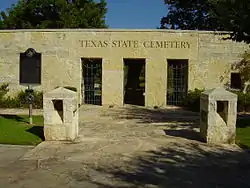 Texas State Cemetery entrance | |
| Location | 901 Navasota Street Austin, Texas, U.S. |
|---|---|
| Coordinates | 30°16′01″N 97°43′34″W |
| Built | 1851 |
| MPS | East Austin MRA |
| NRHP reference No. | 86001085 |
| Added to NRHP | May 12, 1986 |
It is a popular tourist attraction and colloquially referred to as the "Arlington of Texas" because of the notoriety of those interred and proximity to the seat of government.[1]
The cemetery is divided into two sections. The smaller one contains around 900 graves of prominent Texans, while the larger has over 2,000 marked graves of Confederate veterans and widows. There is room for 7,500 interments; the cemetery is about half full, after including plots chosen by people who are eligible for burial.
Burial guidelines
The guidelines on who may be buried within the Texas State Cemetery were first established in 1953, and are currently set by Texas state law. Currently, all persons to be buried in the cemetery must be one of the following:[2]
- A former member of the legislature or a member who dies in office.
- A former elected state official or an official who dies in office.
- State official appointed by the governor and confirmed by the Legislature who served at least 10 years in the office. After September 1, 2015, this criterion may be used only upon approval of the State Cemetery Committee if it finds the official made a significant contribution to Texas history.[3]
- Individual designated by governor's proclamation, concurrent resolution of the Legislature, or order of the State Cemetery Committee; but only after approval of the committee if it finds the individual made a significant contribution to Texas history. The statute as written permits the committee to deny burial under this criterion even if requested by the governor or Legislature.
- The spouse of anyone meeting the above criteria.
- The child of an eligible member, but only if he or she was dependent on another due to a long-standing physical or mental condition during the lifetime of one of the child's parents.
History

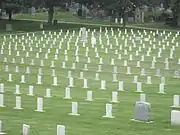
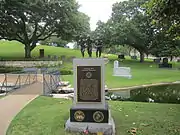
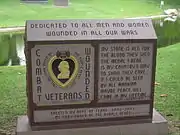

After the death of Edward Burleson in 1851, the Texas Legislature arranged for his burial on land formerly belonging to Andrew Jackson Hamilton. In 1854, the Legislature established a monument at Burleson's grave-site for $1,000 and purchased the surrounding land. The burial ground was virtually ignored until the Civil War, when Texas Confederate officers killed in battle were buried there. In 1864 and 1866 more land was purchased for veterans' burials. An area of 1-acre (4,000 m2) was also set aside for graves of Union veterans (all but one later removed, to Fort Sam Houston National Cemetery in San Antonio). The remaining Union soldier is Antonio Briones, who was left at the request of his family. He is interred alone in the far northwest corner of the cemetery.
Because the Texas Confederate Men's Home and the Confederate Women's Home were located in Austin, more than two thousand Confederate veterans and widows are interred at the State Cemetery. Most were buried after 1889. The last Confederate veterans in the Cemetery were reinterred in 1944; the last widow, in 1963.
In 1932, the State Cemetery was little known and had no roads. There was a dirt road running through the grounds of the Cemetery linked to what was then called Onion Creek Highway. The road kept its highway status when Texas historian Louis Kemp brought it to the attention of the Texas Highway Department that the road running through the Cemetery should be paved. The roads, which are officially designated as State Highway 165, are dedicated to Kemp, and were for a time known as "Lou Kemp Highway". Kemp was also the driving force behind the reinterment of many early Texas figures in time for the Texas Centennial in 1936.
The cemetery was added to the National Register of Historic Places in 1986, but by the early 1990s, the State Cemetery had fallen into disrepair—suffering from vandalism and decay—and was unsafe to visit. In 1994, after noting the condition of the Cemetery, Lieutenant Governor Bob Bullock initiated a three-year project that added a visitor center and renovated the cemetery. In 1997, there was a re-dedication and a reopening of the State Cemetery.
A three-person Texas State Cemetery committee oversees operations at the cemetery. Benjamin M. Hanson (appointed by Governor Greg Abbott) is chairman. James L. Bayless (Speaker's appointment) and Carolyn Hodges (appointee of the lieutenant governor) also serve. The senior historian is Will Erwin.
Former Governor and United States President George W. Bush announced his intention to be buried in the State Cemetery. However, in August 2018, Bush decided he and his wife will be buried at his presidential center following their death.
Statistics
As of 2019, buried in the Texas State Cemetery are:
Davis Guards Medal recipients
- Michael Carr (Section:Confederate Field, Section 2 (D) Row:Q Number:34)
- David Fitzgerald (Section:Confederate Field, Section 1 (F) Row:P Number:7)
- John Flood (Section:Confederate Field, Section 2 (D) Row:V Number:21)
- William Hardin (Section:Confederate Field, Section 1 (F) Row:K Number:15)
- Thomas Sullivan (Confederate Field, Section 2 (D) Row:U Number:18)
Notable interments
- Joseph Hugh Allen
- Betty Andujar
- Bob Armstrong
- Stephen F. Austin
- Moseley Baker
- Don Baylor
- Cedric Benson
- George Beto[4]
- Anita Lee Blair
- Paul Bolton
- Elton Bomer (wife interred; he is still living)
- Andrew Briscoe
- Betty Brown (pending)
- Guy M. Bryan
- Benjamin F. Bryant
- Bob Bullock
- Edward Burleson
- George W. Bush (pending)[5]
- Laura Bush (pending)
- Gregory Scott Coleman
- Waggoner Carr
- Phil Cates
- Gene Cernan[6]
- George Christian
- John B. Connally
- Nellie Connally
- Wayne Connally (cremated, with cenotaph)
- Trammel Crow
- Russell B. Cummings
- Tony Dale (pending)
- Edmund J. Davis
- Susanna Dickinson
- J. Frank Dobie
- John Holt Duncan
- Alexander Campbell Earle (Co-Founder of Delta Tau Delta (ΔΤΔ) Fraternity)[7]
- Robert Eckels (pending)
- Ray Farabee
- James E. Ferguson
- Miriam A. "Ma" Ferguson
- Joe Bertram Frantz
- Fred Gipson
- Lena Guerrero
- James Washington Guinn
- Kent Hance (pending)
- Dorsey B. Hardeman
- Warren G. Harding (Texas politician)
- Talmadge L. Heflin (pending)
- John Hemphill
- James Pinckney Henderson
- Jack English Hightower
- Paul John Hilbert[8]
- Andrew Jackson Houston
- John Ireland
- Patrick Churchill Jack
- William Houston Jack
- Barbara Jordan
- Albert Sidney Johnston
- Delwin Jones
- William Wayne Justice
- Larry L. King
- Dan Kubiak
- L. B. Kubiak (pending)
- Edmund Kuempel
- Chris Kyle (US Navy SEAL)
- Tom Landry (cenotaph)
- Thomas C. Lea, III
- Ray Allen Lemmon[9] (Texas House of Representatives for the 61st and 62nd Legislatures)
- Frank Madla
- Benjamin McCulloch
- George "Spanky" McFarland[10]
- Crawford Martin
- Jim Mattox
- William Menefee
- Walter Mengden (pending)
- James A. Michener (cenotaph)
- John T. Montford (pending)
- Dan Moody
- Jose Antonio Navarro
- James Robertson Nowlin (pending)
- James E. Nugent
- Monty Oum
- Richard Arvin Overton
- William Neff "Bill" Patman
- Randy Pendleton
- Anita Thigpen Perry (pending)
- Rick Perry (pending)
- J. J. Pickle
- George Boyd Pierce (pending)
- William C. Powers Jr.
- Richard "Cactus" Pryor
- Irma Lerma Rangel
- Ann Richards
- Sterling C. Robertson
- Joel Walter Robison
- Darrell K. Royal
- Jerry Sadler
- William Read Scurry
- Gwyn Shea (husband interred; pending)
- Max Sherman (pending)
- Allan Shivers
- E L Short
- Edwin "Bud" Shrake
- Preston E. Smith
- W. E. "Pete" Snelson
- James Austin Sylvester
- Alexander Watkins Terrell[11]
- Ernest O. Thompson
- May Peterson Thompson
- Homer Thornberry
- Sidney Johnson Thomas[12]
- John G. Tower (cenotaph)
- Joanna Troutman
- Byron M. Tunnell
- William A. A. "Bigfoot" Wallace
- Gary Watkins (cenotaph)
- Walter Prescott Webb
- Willie Wells
- George E. "Buddy" West[13]
- John A. Wharton
- Mark White
- James Charles Wilson
- Will Wilson
- Charlie Wilson (Cenotaph)
- Ralph Yarborough
Governors of Texas
- Peter Hansbrough Bell
- John Bowden Connally, Jr.
- Edmund Jackson Davis
- Miriam "Ma" Amanda Ferguson
- James "Pa" Edward Ferguson
- James Pinckney Henderson
- John Ireland
- Francis Richard Lubbock
- Dan Moody, Jr.
- Ann Willis Richards
- Hardin Richard Runnels
- Robert Allan Shivers
- Preston Earnest Smith
- Mark Wells White
Texas Rangers
- Stephen F. Austin
- Willis Thomas Avery
- Jesse Billingsley
- Joseph Graves Booth
- John Watkins Bracken
- Guy Morrison Bryan
- Ben Franklin Bryant
- George Christopher Brakefield
- Edward Burleson
- James Hughes Callahan
- Walter P. Callaway
- William Angelo Dial
- Homer Garrison
- John Grumbles
- Joseph Sidney Fletcher
- William Polk Hardeman
- John Reynolds Hughes
- Ben McCulloch
- Charles Edward Miller
- Daniel Webster Roberts
- James Lambert "Skippy" Rundell
- William Read Scurry
- Lamartine Pemberton "Lamar" Seeker
- William Tom
- William Alexander Anderson "Big Foot" Wallace
- Eleazar Louis Ripley Wheelock
- John Lemon Wilbarger
- Robert McAlpin Williamson
- Thomas C. Wilson
- William Delpard Wilson
Other
- 1 Navy SEAL
- 5 Lieutenant Governors of Texas
- 5 Speakers of the Texas House of Representatives
- 15 Signers of the Texas Declaration of Independence
- 3 U.S. Senators
- 6 U.S. Representatives
- 5 First Ladies of Texas (including planned burial plots for Anita Thigpen Perry who are still alive)
- 5 authors
- 11 Republic of Texas veterans
- 9 Confederate Generals
- 3 Medal of Honor recipients
- 2 American Revolutionary War veterans
- 1 17th-century French sailor (remains discovered in the wreck of La Salle's ship La Belle in 1996)
- First Texas Solicitor General
- 1 member of the Baseball Hall of Fame
- 1 astronaut
- 1 president of the University of Texas at Austin
- 1 football player
- 1 notable supercenterian
Popular culture
- In one episode of King of the Hill, Cotton Hill is awarded a plot in the Texas State Cemetery for his heroism during World War II. However, Cotton is never buried in this plot when he dies in another episode. Actor Barry Jenner, who appeared in 27 episodes of the 1980s television series Dallas, is also awarded a plot.
Gallery
 Crescent Pond
Crescent Pond Opposite end of the pond
Opposite end of the pond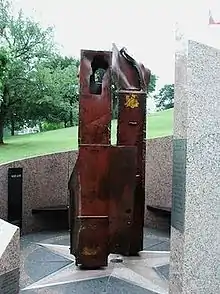 September 11, 2001, memorial
September 11, 2001, memorial Main flagpole, on the hilltop
Main flagpole, on the hilltop A section marker
A section marker Visitor center
Visitor center Texas State Cemetery as seen from East 7th Street
Texas State Cemetery as seen from East 7th Street
See also
 Texas portal
Texas portal Biography portal
Biography portal
References
- Hashimoto, Raoul. "The Texas State Cemetery, "The Arlington of Texas"". Texas Escapes Online Magazine.
- Texas Government Code, Chapter 2165 (Section 2165.256, subsections (d), (e) & (f))
- HB 2206, 2015 Texas Legislature (Section 2)
- "Beto, George John." Handbook of Texas. Retrieved on August 8, 2010.
- Texas State Cemetery. "George Walker Bush".
- The Last Man on the Moon DVD 'Final Resting Place' 2015
- http://www.cemetery.state.tx.us/pub/user_form.asp?pers_id=1091
- https://cemetery.tspb.texas.gov/pub/user_form.asp?pers_id=9430
- "Archived copy". Archived from the original on 2011-08-18. Retrieved 2011-06-01.CS1 maint: archived copy as title (link)
- Texas State Cemetery
- Nichols, Irby C., Jr. (June 15, 2010). "TERRELL, ALEXANDER WATKINS". Handbook of Texas Online. Texas State Historical Association. Retrieved December 28, 2015.
- Texas State Cemetery. "Mary Andrus Jones".
- Texas State Cemetery
External links
| Wikimedia Commons has media related to Texas State Cemetery. |
- Official website
- Texas State Cemetery searchable database. One can search by name or by location in the cemetery.
- State Cemetery from the Handbook of Texas Online
- Political Graveyard list of politicians buried in the Texas State Cemetery.
- Where They R.I.P. Site dedicated to finding the burial locations of Texas's elected officials from the Republic Era to statehood. Includes lists of African-American legislators, governors and other elected officials.
- Texas State Cemetery at Find a Grave